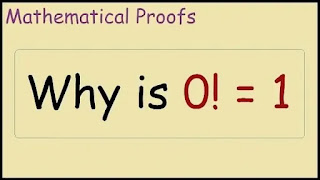Factorials are an important mathematical concept that arise in many different fields, including combinatorics, probability theory, and calculus. They are used to calculate the number of ways that a set of objects can be arranged in a particular order. For example, the factorial of 5 (written as 5!) is calculated as 5 × 4 × 3 × 2 × 1 = 120, which represents the number of ways that 5 objects can be arranged in a row.
Factorials are often used in counting problems, such as the number of permutations and combinations of a set of objects. Permutations are the number of ways that a set of objects can be arranged in a particular order, while combinations are the number of ways to select a subset of objects from a larger set, without regard to order.
For example, suppose we have a set of 3 objects {A, B, C}. The number of permutations of this set is 3! = 6, which represents the number of ways that the objects can be arranged in a row:
ABC, ACB, BAC, BCA, CAB, CBA
The number of combinations of this set, taken 2 at a time, is given by the formula:
3 choose 2 = 3! / (2! * 1!) = 3
This represents the number of ways to choose 2 objects from the set, without regard to order:
AB, AC, BC
Factorials are also used in calculus, where they arise in the Taylor series expansion of functions. The Taylor series is a way of representing a function as an infinite sum of terms, where each term is a derivative of the function evaluated at a particular point. The coefficients of the terms in the series are given by the function's derivatives evaluated at the point of expansion.
Factorials are a fundamental concept in mathematics that arise in many different fields, and are used to calculate the number of ways that a set of objects can be arranged in a particular order. By understanding factorials, we can gain a deeper understanding of counting problems, calculus, and other mathematical fields.
What is 0 factorial?
Factorials are defined for positive integers, but what about 0? It turns out that 0! has a special value, which is 1. This may seem counterintuitive at first, since 0! is the product of no numbers, but there are good reasons why 0! is defined to be 1.
First, let's define what we mean by 0 factorial. We can use the recursive definition of factorials to extend the factorial function to include 0:
n! = n * (n-1) * (n-2) * ... * 2 * 1
0! = 1
In other words, 0! is the product of no numbers, but we define it to be 1. This definition is consistent with the way that factorials are used in mathematics, and it simplifies many calculations involving factorials.
For example, consider the formula for calculating combinations:
n choose k = n! / (k! * (n-k)!)
If we were to use the definition of factorials without 0!, this formula would be undefined when k=0 or k=n, since we would be dividing by 0! or (n-k)!, which are undefined. By defining 0! to be 1, this formula is well-defined for all values of k.
Another reason why 0! is defined to be 1 is that it makes sense from a combinatorial perspective. Suppose we have a set of 0 objects. How many ways are there to arrange this set? There is only one way, namely the empty arrangement. In other words, there is exactly 1 arrangement of a set of 0 objects, which corresponds to 0! = 1.
Furthermore, there are many other formulas in mathematics that involve factorials, and defining 0! to be 1 simplifies these formulas as well. For example, the Taylor series expansion of e^x is given by:
e^x = 1 + x + x^2/2! + x^3/3! + ...
If we were to exclude 0! from this formula, the coefficient of the x^0 term would be undefined. By defining 0! to be 1, we can include this term in the formula and simplify the calculation of derivatives of e^x.
0! is defined to be 1 for good reasons, including consistency with other mathematical formulas, simplification of calculations, and combinatorial arguments. While it may seem counterintuitive at first, this definition makes sense in the context of factorials and simplifies many calculations in mathematics.
Why is 0 factorial equal to 1?
At first glance, the idea that 0! is equal to 1 might seem counterintuitive, but there are several reasons why this is the case. In this section, we will explore two different approaches to understanding why 0! is equal to 1: through combinatorics and through the gamma function.
1. Combinatorics
Combinatorics is a branch of mathematics that deals with counting and arranging objects. The factorial function arises naturally in combinatorics when we want to count the number of ways to arrange a set of objects. For example, the number of permutations of n objects is given by n!, while the number of combinations of n objects taken k at a time is given by n!/k!(n-k)!. These formulas allow us to compute the number of ways to arrange objects in various ways, and they are used in many areas of mathematics and science.
Now, let's consider the case of a set with 0 objects. How many ways are there to arrange this set? Intuitively, it might seem like there are no ways to arrange a set of 0 objects, since there are no objects to arrange. However, we can think of the empty arrangement as a valid arrangement. In other words, there is exactly 1 arrangement of a set of 0 objects, which corresponds to 0! = 1.
To see why this is the case, let's consider an example. Suppose we have a set of 4 objects: A, B, C, and D. We can arrange these objects in 4! = 24 ways:
ABCD, ABDC, ACBD, ACDB, ADBC, ADCB,
BACD, BADC, BCAD, BCDA, BDAC, BDCA,
CABD, CADB, CBAD, CBDA, CDAB, CDBA,
DABC, DACB, DBAC, DBCA, DCAB, DCBA.
Now suppose we have a set of 0 objects. We might be tempted to say that there are 0 ways to arrange this set, but this would be incorrect. In fact, there is exactly 1 way to arrange a set of 0 objects: the empty arrangement. This corresponds to 0! = 1. While this might seem counterintuitive, it is a convention that is widely used in mathematics and science.
2. The Gamma Function
The gamma function is an extension of the factorial function to complex numbers. It is defined by the following integral:
Γ(z) = ∫[0,∞] t^(z-1) e^(-t) dt
This integral is defined for all complex numbers z except for the nonpositive integers (0, -1, -2, ...), where it has singularities. However, the gamma function can be analytically continued to include these singularities, and it turns out that Γ(1) = 1.
To see why this is true, we can use integration by parts and some elementary calculus. Let u = t^(z-1) and dv = e^(-t) dt, so that du = (z-1)t^(z-2) dt and v = -e^(-t). Then we have:
Γ(z) = ∫[0,∞] t^(z-1) e^(-t) dt
= [-t^(z-1) e^(-t)][0,∞] + (z-1)∫[0,∞] t^(z-2) e^(-t) dt
= [0^(z-1) e^(-0)] - lim[t^(z-1) e^(-t)][t→∞] + (z-1)Γ(z-1)
= 0 + 0 + (z-1)Γ(z-1)
Simplifying this expression, we get:
Γ(z) = zΓ(z-1)
Using this recursion formula, we can evaluate Γ(1) as follows:
Γ(1) = 1Γ(0)
= 1×(−1)!
= 1
Here, we have used the fact that Γ(z) = (z-1)! for positive integers z. Therefore, we can conclude that Γ(1) = 1, which implies that 0! = Γ(1) = 1.
The gamma function is a powerful tool in mathematics and has applications in many areas, including number theory, analysis, and physics. In fact, the gamma function is closely related to other important functions, such as the beta function and the zeta function.
Applications of 0 Factorial
The concept of 0 factorial may seem abstract and theoretical, but it has important applications in various areas of mathematics, science, and engineering. In this section, we will discuss some of the key applications of 0 factorial.
Use in Mathematical Formulas
0 factorial is commonly used in mathematical formulas to simplify expressions and make them more elegant. For example, consider the binomial coefficient formula:
n choose k = n! / (k! * (n-k)!)
This formula gives the number of ways to choose k items from a set of n items. If k = 0, the formula reduces to:
n choose 0 = n! / (0! * n!) = 1
This formula tells us that there is only 1 way to choose 0 items from a set of n items, which makes sense because there is only 1 empty set.
Another example is the formula for the number of derangements of n objects, which is given by:
!n = n! * (1 - 1/1! + 1/2! - 1/3! + ... + (-1)^n/n!)
This formula gives the number of ways to arrange n objects such that none of them are in their original position. If n = 0, the formula reduces to:
!0 = 1
This tells us that there is only 1 way to arrange 0 objects such that none of them are in their original position, which corresponds to the empty arrangement.
Importance in Probability and Statistics
0 factorial also has important applications in probability and statistics, where it is used to compute probabilities of events and expected values of random variables. For example, consider the Poisson distribution, which is a discrete probability distribution that describes the number of events that occur in a fixed interval of time or space. The probability mass function of the Poisson distribution is given by:
P(X = k) = e^(-λ) * λ^k / k!
where λ is the mean number of events in the interval and k is the number of events.
If λ = 0, then the formula reduces to:
P(X = k) = e^(-0) * 0^k / k! = 0 / k! = 0
This tells us that the probability of observing k events in the interval is 0 when the mean number of events is 0, which makes sense because there are no events to observe.
Another example is the expected value of a random variable, which is a measure of the central tendency of the distribution of the variable. If the random variable takes on nonnegative integer values, then its expected value can be computed using the following formula:
E(X) = ∑k=0 to ∞ k * P(X = k)
If the probability mass function of the variable is given by the Poisson distribution with mean λ, then the formula reduces to:
E(X) = λ
If λ = 0, then the expected value is:
E(X) = 0
This tells us that the expected value of a random variable that takes on nonnegative integer values is 0 when the mean value is 0, which corresponds to the case where there are no events to observe.
👉 Read more posts with the same topic
Conclusion
We have seen that the concept of 0 factorial can seem counterintuitive at first, but there are sound mathematical reasons for why it is defined as 1. We have explored two different approaches to understanding why 0! is equal to 1: through combinatorics and through the gamma function. Both of these approaches arrive at the same result, and this result is widely accepted and used in mathematics and science.
Furthermore, we have seen that the concept of 0 factorial has important applications in many areas of mathematics and science. It is used in various mathematical formulas, such as the binomial theorem and the Taylor series expansion, and it plays an important role in probability and statistics. For example, the number of ways to choose 0 objects from a set of n objects is 1, which corresponds to 0! = 1. This is an important result in probability theory, and it has many applications in fields such as economics, engineering, and physics.
Overall, understanding the concept of 0 factorial is essential for anyone studying mathematics or science, and it has implications that go far beyond the simple question of why 0! is equal to 1. As we have seen, it is a fundamental concept that is used in many areas of mathematics and science, and it is an essential tool for understanding and solving problems in these fields.








0 Comments